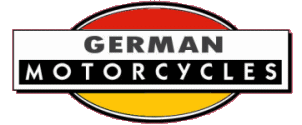

A Brief History of the Marque
Manufactured from 1922 to 1928 by Max Bernhardt & Co. of Berlin, founded in 1910 as a bronze art casting workshop.
Introduced at the 1922 Berlin Motor Show, these motorcycles were fitted with V-twins of 598cc supplied by aircraft engine manufacturer Siemens & Halske, and had a very similar appearance to the Indian Scout - so much so that when they changed the colour scheme from green to red, Indian sued. [1]
In those days of financial turmoil in Germany the company endured many problems including lack of engine supply due non-payment of bills. This resulted in reorganisation - the company name became Mabeco-Werke G.m.b.H with Siemens & Halske as the main shareholder, and Max Bernhardt as commercial director.
1925 saw the introduction of a 746cc machine which corresponded to the Indian 45ci Scout.
In 1926 and 1927 they built road-racing motorcycles with OHV engines using four-valve heads. These were very advanced machines which had alloy barrels with cast iron liners - this in the days where a good many competitors were still using cast iron pistons - and were also highly distinctive, having four exhaust pipes. These ones were not at all like the Indian.
The racing machines achieved considerable success in the hands of such riders as Alfred Pätzold, Gustav Dierks, and Erich Tennigkeit. Ilse Thouret placed first in a 1927 race riding a 750cc Mabeco. She later became a factory rider for Puch.
Utility Tricycles.
In 1925 Mabeco introduced the Mabeco-Last with a 746cc V-twin engine, motorcycle-style front end, and a goods tray supported by two rear wheels allowing for a payload of over half a tonne. Although not designed as a personel carrier, an image shows the machine with 12 passengers and the rider aboard.
Mabeco also built a 346cc two-stroke "twingle" under licence from Garelli. It was named the Mabeco-Garelli.
Mabeco ceased production in 1928. Total production is thought to be in the realm of 3,400 motorcycles and three-wheelers.
Notes.
1. Yesterdays.nl says there is no evidence that Indian sued Mabeco.
2. A Mabeco has been exhibited at the American Motorcycle Museum, Holland.
3. The name Mabeco is used in Angola for the African Wild Dog, or Painted Wild Dog, a quite extraordinary creature which lives in a matriachal society and simply vanishes into the svelte when stationary due to its brilliant camoflage. It has only three enemies - lions (which kill them because they're competition), hyenas (which kill them and eat them), and humans (which kill everything).
Sources: GTU Oldtimerservice, South-Bohemian MC Museum, Axel Oskar Mathieu Archive, Yesterdays.nl.
If you have a query or information about Mabeco motorcycles please contact us